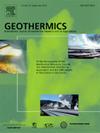Sampling and analysis of H2S and Hg from evaporative geothermal cooling towers: The Italian experience
IF 3.5
2区 工程技术
Q3 ENERGY & FUELS
引用次数: 0
Abstract
The Italian regulatory framework on geothermal power plants requires measurement of the emission of H2S and Hg from cooling towers. Sampling of emitted air in geothermal plants is a quite complex task requiring specific non-standard methods in order to collect stable and representative samples. A direct application of standard methods for H2S and Hg emissions to cooling tower is often not suitable or difficult to apply. The standard methods indeed were developed for sampling in the stacks of combustion plants such as power generation or cement production plants. The drastic difference in temperature, humidity, air flow composition and velocity and moreover geometrical difference between stacks with diameters of few meters compared to cells of cooling towers, very often over 5–9 m, required a special setup of methods for sampling and analysis. Enel Green Power and Consiglio Nazionale delle Ricerche (Italy) thus have carried out a screening of the existing methods and some of them were customized and extended for their application on cooling towers of geothermal power plants. The main results obtained provided suitable sampling and analysis methods for H2S in the range 0.2–25 mg/Nm3 and for mercury between 20–500 µg/Nm3. The aforementioned sampling and analysis methods are currently adopted by EGP and by the regional agency for environmental protection (ARPAT) for the measurement of H2S and Hg emission from cooling towers of geothermal power plants in Italy.
蒸发式地热冷却塔中硫化氢和汞的取样和分析:意大利的经验
意大利对地热发电厂的监管框架要求测量冷却塔中硫化氢和汞的排放量。地热发电厂排放空气的采样是一项相当复杂的任务,需要特定的非标准方法来收集稳定和有代表性的样本。直接采用标准方法对冷却塔进行硫化氢和汞排放往往不适合或难以实施。标准方法确实是为在燃烧工厂如发电厂或水泥生产厂的烟囱中取样而开发的。温度、湿度、气流组成和速度的巨大差异,以及直径几米的烟囱与冷却塔单元之间的几何差异,通常超过5-9米,需要特殊的采样和分析方法设置。因此,Enel Green Power和Consiglio Nazionale delle Ricerche(意大利)对现有方法进行了筛选,并对其中一些方法进行了定制和扩展,以便应用于地热发电厂的冷却塔。得到的主要结果为0.2 ~ 25 mg/Nm3范围内的H2S和20 ~ 500µg/Nm3范围内的汞提供了合适的采样和分析方法。上述采样和分析方法目前被EGP和区域环境保护机构(ARPAT)用于测量意大利地热发电厂冷却塔的H2S和Hg排放。
本文章由计算机程序翻译,如有差异,请以英文原文为准。
求助全文
约1分钟内获得全文
求助全文
来源期刊

Geothermics
工程技术-地球科学综合
CiteScore
7.70
自引率
15.40%
发文量
237
审稿时长
4.5 months
期刊介绍:
Geothermics is an international journal devoted to the research and development of geothermal energy. The International Board of Editors of Geothermics, which comprises specialists in the various aspects of geothermal resources, exploration and development, guarantees the balanced, comprehensive view of scientific and technological developments in this promising energy field.
It promulgates the state of the art and science of geothermal energy, its exploration and exploitation through a regular exchange of information from all parts of the world. The journal publishes articles dealing with the theory, exploration techniques and all aspects of the utilization of geothermal resources. Geothermics serves as the scientific house, or exchange medium, through which the growing community of geothermal specialists can provide and receive information.
 求助内容:
求助内容: 应助结果提醒方式:
应助结果提醒方式:


